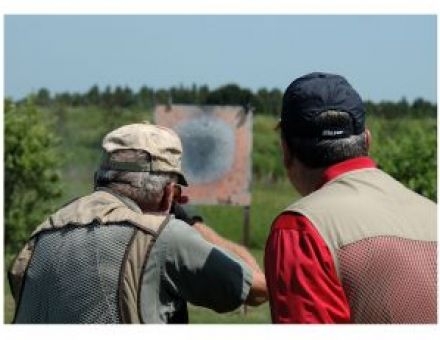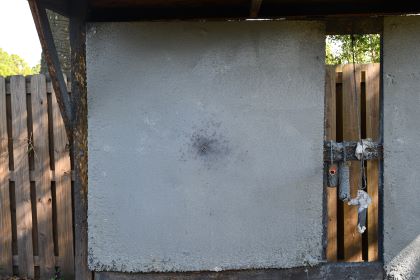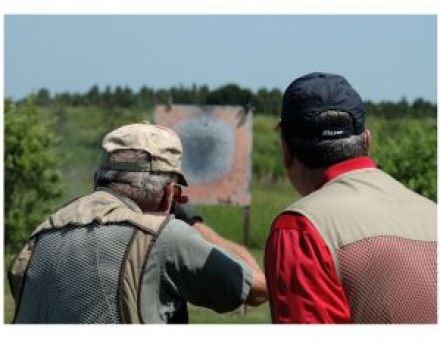Exclusive Excerpt from Don Currie’s New Book “Gunfitting: Achieving the Ideal Fit for the Game and Clay Shot”

Warning: Never use steel shot on a pattern plate; and, as always, eye and ear protection are essential. Lead shot flattens when it makes contact with the pattern plate and most of the time falls harmlessly to the ground following impact.
Here is an exclusive selection from Don Currie’s forthcoming book “Gunfitting: Achieving the Ideal Fit for the Game and Clay Shot.” This excerpt is from Chapter 11 “Sighting in the Shotgun.”
The Pattern Plate
Warning: Never use steel shot on a pattern plate; and, as always, eye and ear protection are essential. Lead shot flattens when it makes contact with the pattern plate and most of the time falls harmlessly to the ground following impact. Occasionally you may experience a stray ricochet, which is why wearing eye protection is important for you and anyone in the vicinity. Steel or tungsten-based shot, however, will always ricochet. If you can find no alternative to patterning with steel shot, use wood or paper as your target, and stand at least 25 yards away from the plate. Do not shoot steel shot at a steel pattern plate or any other backstop that will not absorb the shot or allow it to pass through.

For the purpose of checking the fit of a shotgun, a shooter and gunfitter generally head to the pattern plate (i.e., “pattern board”), seeking the answers to one of two questions: (1) Does my gun shoot where I’m looking (POI)? and (2) Do both barrels shoot to the same spot (barrel regulation for double-barreled shotguns)? Of course you can also visit the pattern plate to conduct pattern analysis. If you are an analytical type, an engineer, or an accountant, you can experience the endless enjoyment that accompanies a detailed study of pattern densities at different distances for all fourteen of the chokes in your range bag. Once satisfied that each choke-and-shell combination delivers sufficient pellets to kill a target at a given distance, you will be much better informed. You will not, however, shoot any better. In general, shooters spend far too much time worrying about chokes and pattern density. But if this “winds your clock,” march on!
While a pattern plate may conform to any number of designs, the ideal is a 40́ 40-inch (~100 cm square) steel plate (or larger) with a small hole, or other focal point, in the center of the plate. The plate is normally mounted on poles, with the center of the plate elevated to a height of about 5 feet (1.5 meters) off the ground. By coating the pattern plate with spray paint (least preferred), industrial grease, or combination of the two (my preference), one can easily see the two-dimensional impression that lead pellets leave on the plate after impact. A standard paint roller is the best way to apply the substance and refresh the pattern plate after each use. When patterning a shotgun for POI, the shooter should stand at a distance of 16 yards from the plate. At this distance, a 1-inch deviation from the focal point (i.e., point-of-aim) on the pattern plate mathematically translates to 1/16” of deviation at the heel of the shotgun.

When shooting at a pattern plate, use a fairly tight choke – at least a modified (one-half choke) but preferably tighter. The impression we see on the pattern plate is a two-dimensional one. If the impression on the pattern plate is tight enough, you can clearly see that the shot impressions at the center of the pattern are more concentrated and the impressions on the outside of the pattern are more widely disbursed compared to the center. It is the center of the pattern that we identify as the POI.
As a gunfitter, I rely greatly on the use of a pattern plate as the initial test of fit, but it is only one of three important means of evaluating and adjusting the fit of a shotgun to align the POI with the point-of-aim. If you attempt this yourself, use a fairly tight choke (modified, one-half, or tighter) so that the center of the pattern is readily discernable. As you execute your shot, apply acute visual focus to the focal point of the pattern plate, and fire.
The most important thing to remember when executing a shot at a pattern plate for POI testing is that the gun must be raised smoothly and efficiently to the cheek while maintaining visual focus on the focal point at the center of the pattern plate. You should avoid aiming the shotgun using the front bead but instead continue to focus on the focal point through your shot execution. If you aim the shotgun instead of pointing it, the results on the pattern plate will not translate to the field or the clays course. The mount must be natural, as you would mount your gun to a moving target. A well-practiced gun mount and continuous visual focus on the focal point are essential to an effective result and POI analysis. I always shave the shooter assume a ready position that is very close to a pre-mounted or high-gun ready position, with the comb about 1 to 2 inches below the cheek (~2 to 5 cm) with barrels parallel to the ground. I instruct the shooter to take a couple of practice mounts before shooting, smoothly moving the gun with both hands up to the zygomatic bone, pausing for half a second, and executing the shot. Again, it is critical for the shooter to maintain visual focus on the focal point on the board, with good visual follow-through as the shot is executed. Once the shot is executed and the gun is made safe, the pattern made by the pellets impacting the pattern plate can be analyzed. This process should be repeated at least three times, analyzing the pattern after each shot.

Reading the Pattern Plate
As you analyze the pattern on the pattern plate, identify the center – the spot of greatest concentration of shot pellets. If you are lucky, the center of the pattern will be right where you want it to be in relationship to your point-of-aim. This will normally indicate that when the gun was fully mounted and shot executed, the iris, or eyeball, was perfectly centered and atop the rib of the shotgun. Congratulations! You have a well-fitting gun. However, your shotgun still needs to be shot at moving targets to be sure.

If there is a variance between your point-of-aim and the center of the pattern, and your shotgun is equipped with an adjustable comb, you can “dial in” the gun to achieve the ideal POI. Adjusting the height of the comb upward (thus reducing the “drop-at-comb”) will raise the POI. Lowering the comb (increasing the drop-at-comb) will lower the POI. Moving the comb to the right (for more “cast-off”) will move the POI to the right. Moving the comb to the left (for more “cast-on”) will move the POI to the left. When moving the comb down (increasing drop-at-comb) to lower the POI, be careful not to lower the comb to the point where the iris disappears below the rib when the gun is fully mounted. We will discuss this in much greater detail later.
Whenever discussing pattern performance, the inevitable subject of shot distribution arises. Let’s assume that you are using a pattern plate to evaluate point-of-impact and the shot pattern is dead center horizontally (the pattern is evenly distributed with 50 percent of the shot impressions to the left and 50 percent to the right of an imaginary vertical line drawn through your focal point). This means your cast is perfect. However, what percentage of your shot pattern should be above and below this imaginary horizontal line? The general consensus is: If you primarily shoot rising targets, like trap and upland birds over pointers, your gun should pattern at about 70 percent above and 30 percent below the visual focal point. For sporting clays and skeet, the distribution should be between 50/50 and 60/40 (60 percent above and 40 percent below the point-of-aim). To a certain degree, this is a matter of preference; however, these are the general guidelines. For example, many sporting clays shooters like a gun that shoots 60/40, but I personally prefer a flatter shooting gun (50/50), given the percentage of sporting clays targets that curl and transition.
Reading POI on Targets
The pattern plate remains an important indicator for the gunfitter; however, it has its draw backs. Sporting shotguns are designed to be shot dynamically (pointed at a moving target) not statically(pointed at a stationary target). Shooting at a pattern plate is somewhat artificial and does not replicate actual shotgunning on a moving target; however, it is a good initial indicator of fit. As mentioned earlier, it is quite common for shooters to mount differently on moving targets than they do on a stationary pattern plate. This, in turn, can cause a noticeable difference in POI when shooting a moving target versus the stationary pattern plate.
While evaluating POI on moving clay targets is critical to determining proper gun fit, it can be difficult for the uninitiated to observe and accurately assess the pattern-target relationship as theshot string passes or intersects the target. The shooter should never try to evaluate this by himself, because it is very difficult and can result in the shooter mounting differently and ejecting from the gun too quickly to see the target break. It is always advisable to have a gunfitter, experienced coach, or another experienced shooter who can discern the inflight relationship between the target and shot string. The primary means by which the trained observer can diagnose POI on moving targets is to either correctly observe the barrel-target relationship at the moment of shot execution or observe the actual shot string and its relationship with the target. As with shooting at a pattern plate, a relatively tight choke should be used for dialing in a shotgun so that the center of pattern is tighter, less forgiving, and therefore more readily discernable.

Shooting at a straightaway trap-style target is an excellent way to “dial in” cast for a shotgun. You can readily see if the pattern impacts the middle of the target, because the target will eitherturn to dust or the dispersion of target fragments will be fairly uniform in all directions, like the starburst created by exploding aerial fireworks. If you see the majority of the pieces disburse in a single direction, this indicates that the target is being struck by the edge ofthe pattern and the shotgun needs some adjustment. For example, if most of the pieces of the target go left upon impact, this means that the center of the pattern is to the right of the target and the target is being struck on its right side. If using a try-gun or other shotgun equipped with an adjustable comb, you would adjust your comb to the left slightly, until the center of the shotstring impacts the center of the target. It is important that the target presentation be a straight, flat-trajectory trap-style target. It is also important that you evaluate POI on multiple targets from the same trap machine and shooting position to isolate any potential issues with mount consistency.

As the second target presentation, I recommend using a flat-trajectory crossing target to evaluate drop-at-comb. You can readily see if the pattern impacts the middle of the target because, again, the target will either turn to dust or the dispersion of target fragments will be fairly uniform in all directions. For this target presentation, however, we are looking for the accuracy of the gun’s movement in comparison to the target line. A miss behind or in front, or chipping the front or back of the target, does not necessarily indicate a fitting problem but could instead be shooter error. Again, we always want to diagnose gun fit with a repeatable break across a series of target engagements and shot from the same shooting position. If over the course of several targets, you observe the majority of target fragments disbursing downward, this is an indication that the shotstring is impacting the top of the target and that the comb should be adjusted downward to increase drop-at-comb and lower the POI. Conversely, if you observe the majority of target fragments disbursing upward, this is an indication that the shot string is impacting the bottom of the target and that the comb should be adjusted up to raise the POI. As mentioned previously, you must be very cognizant of the consequences of adjusting a try-gun or an adjustable comb to a point where the shooter’s eye is too low and close to the rib when he is fully mounted to the shotgun. This will result in the shooter unintentionally occluding the target with the shotgun, losing sight of the target as he completes the mount to the cheek and the shot is executed. This can be a difficult diagnosis, given the fact that you can’t stand at the muzzle end of the shotgun as the shooter executes the shot. Another issue that can influence POI is an eye dominance issue. A right-handed shooter may tend to shoot slightly left and a left-handed shooter slightly right of the point-of-aim if the shooter’s non-shooting eye is influencing POI. One way to rule out the possibility that the non-shooting eye is influencing POI is to briefly cover the non-shooting eye with a piece of tape or a dot prior to making any adjustments for cast. You don’t want to make adjustments to a stock or gun based on a faulty diagnosis that the non-shooting eye is causing a bias in the shooter’s POI.
Don Currie is the chief instructor of the National Sporting Clays Association and one of the most sought-after shooting coaches and gunfitter in our sport. Competing in the shooting sports since age 8 and instructing as an apprentice at age 16, Don is that rare combination of Champion, Instructor, Coach and Gunfitter Don regularly propels shotgun enthusiasts of all ages and experience levels to breakthrough performance whether in the field or in competition. He also fits and equips shooters for custom shotguns. His instructional DVD “Focus – Movement – Faith” is the #1 rated sporting clays DVD on Amazon at https://amzn.to/3jEtt1u. For more about Don, visit his web site at https://doncurrie.com.
Order Don Currie’s New Book “Gunfitting: Achieving the Ideal Fit for the Game and Clay Shot”
Don Currie is one of North America’s most respected gunfitters, shotgun coaches and an award-winning author. In his new book “Gunfitting: Achieving the Ideal Fit for the Game and Clay Shot, “Don delivers a groundbreaking reference work on the proper fit of a shotgun based on a lifetime of experience as a shooter, coach, and gunfitter. He takes the reader far beyond the pattern plate, to a detailed description of how the proper point-of-impact is evaluated on moving targets and how the shooter’s stance, mount, shooting discipline, and level of experience all factor into the final dimensions of the properly fitted shotgun. Don leads us on an informative journey into the stock maker’s workshop, the engraver’s studio, and the gunfitter’s kit bag to round out our understanding of the detail required to achieve the perfect gunfit. Gunfitting will prove to be a highly valued resource and a welcome addition to the book shelf of any shotgun enthusiast, instructor, gunfitter or gunmaker for many years to come.
Pre-order now at https://bit.ly/2UNkKBK

Don Currie is the chief instructor of the National Sporting Clays Association and one of the most sought-after shooting coaches and gunfitter in our sport. Competing in the shooting sports since age 8 and instructing as an apprentice at age 16, Don is that rare combination of Champion, Instructor, Coach and Gunfitter Don regularly propels shotgun enthusiasts of all ages and experience levels to breakthrough performance whether in the field or in competition. He also fits and equips shooters for custom shotguns. His instructional DVD “Focus – Movement – Faith” is the #1 rated sporting clays DVD on Amazon at https://amzn.to/3jEtt1u. For more about Don, visit his web site at https://doncurrie.com.



Comments